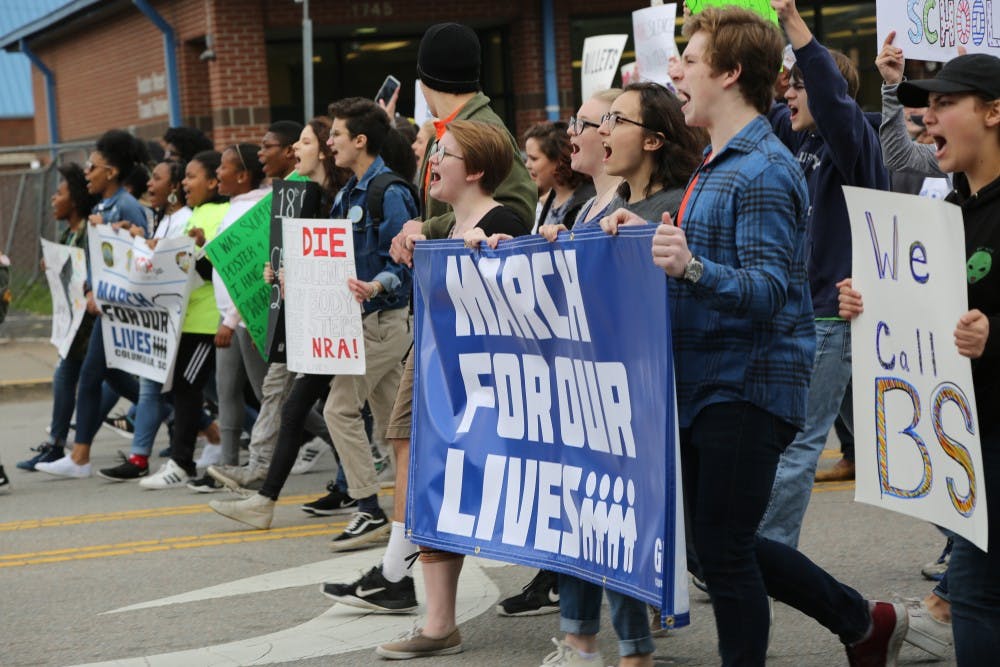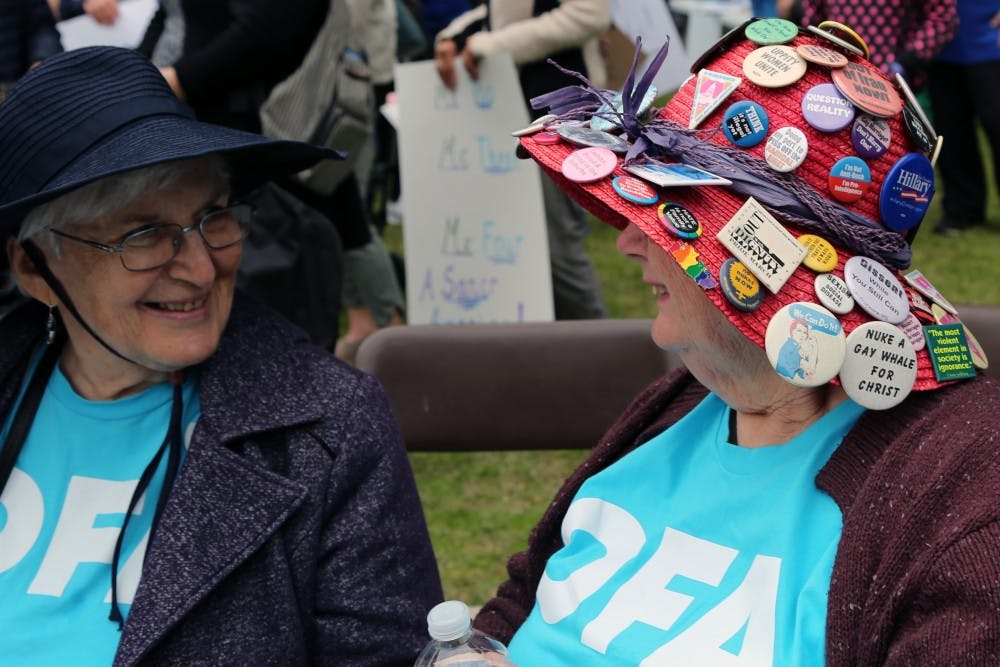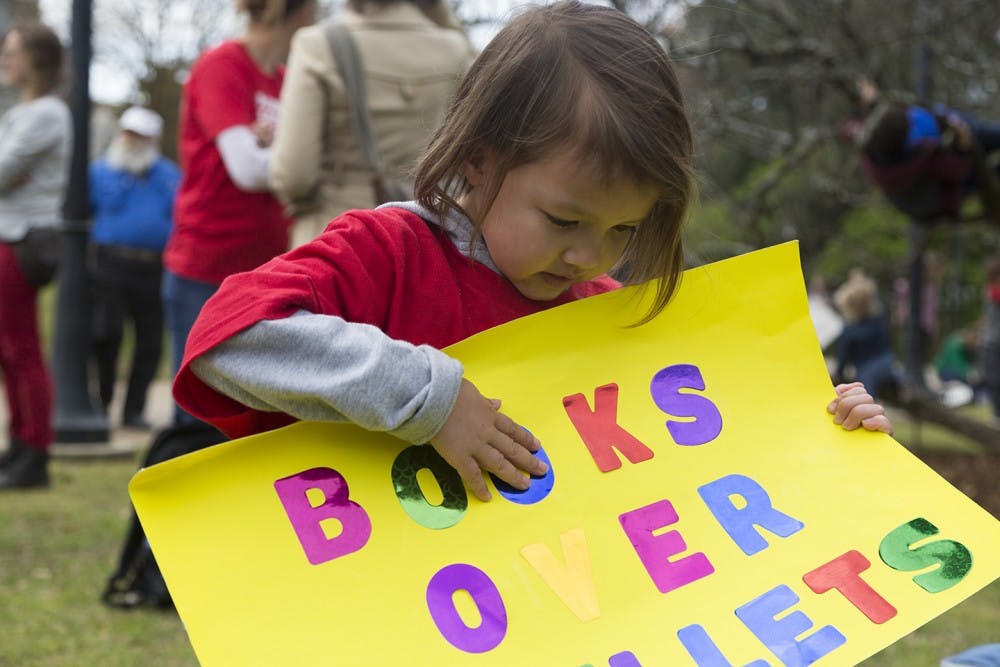"I know how to spell cat: C-A-T," 4-year-old Emma Van Hoogen says proudly. She's starting kindergarten in the fall and eagerly demonstrates what she's already learned.
"Emma, go ahead and tell them why you're here," her mom says.
She answers in a sure but quiet voice almost drowned out by chanting: “Because the student came in and bring the gun and shot a lot of students.”

Across the world on Saturday at more than 800 partner marches, students and gun control supporters protested mass shootings and the lack of legislative response. The March for Our Lives in Columbia drew a small crowd — about 3,000 — compared to the hundreds of thousands in Washington, D.C., but the marchers displayed the same passion and call to action.
"We will out-vote you, we will outlive you, and we will not forgive you," said River Bluff High School's Chloe Thackeray, calling out South Carolina legislators and Gov. Henry McMaster.
Thackeray was one of about 20 people who spoke on the Statehouse steps after a mile-long march along Sumter Street in Columbia. High school students holding banners and megaphones led the march at an unusually fast pace, leaving journalists and photographers running to keep pace and extending the thousands of participants out over four city blocks.
Sarah Hinnant, wearing a neon yellow shirt and holding a neon pink megaphone, walked in front of the masses leading call-and-repeat chants — "Show me what democracy looks like"; "This is what democracy looks like."
Hinnant, a Dreher High School student, clearly outlined in her speech what she wants to happen: banning certain weapons, eliminating loopholes and universal background checks. Other students with different political goals were equally specific, saying that they wanted a certain counselor-to-student ratio or to reduce the political power of the National Rifle Association.

While Van Hoogen was probably at the bottom of the age spectrum able to articulate the reason for the march, many parents carried babies or pushed toddlers in strollers.
“They start learning how to be civically engaged from the very beginning," said Elizabeth Aravena, who came with her husband Patricio and three children younger than 5 years old. "So if we’re not engaged and not participating, they’re not engaged and not participating either.”
Her 4-year-old's school has active shooter drills, something students of all ages are becoming accustomed to.
“Lock the doors, turn off the lights and then you have to hide on the walls so that if the windows break they don’t touch you,” said Skylar, a student at Pine Ridge Middle School in West Columbia.
A Pine Ridge student made a gun threat recently, Skylar said, but is still attending classes there. A number of schools near Columbia have had threats made since the Parkland shooting. Dylann Roof's sister, who attends AC Flora High School in Columbia, made national news when she said on Snapchat that she hoped everyone who walked out March 14 got shot.
Nina Grey was part of the "generation that hid our heads under the table" in nuclear drills at school, she said. She saw a connection between the strong activist response to the nuclear crisis in the '80s and the gun violence protests now.
“We are depending upon this generation to carry forth the torch of social justice and liberty for us all,” Grey's colleague Peg Thompson said. There to register new voters, Thompson wore a hat with protest buttons collected over 40 years.
They registered more than 25 voters at their table, and there were several other voter registration groups working to get people signed up.

Most high school students haven't voted before because they aren't 18, and many college freshman aren't old enough yet either. First-year USC student Ian Bain hadn't been politically active before helping to organize the Columbia March for Our Lives. He turned 18 in June and hasn't voted yet, but said he'll be voting in the midterms in November.
Will candidates' positions on gun control impact how Bain votes?
"Definitely."
Bain got interested in politics after the Feb. 14 shooting of 17 students at Marjorie Stoneman Douglas High School, which was also the spark for March for Our Lives. While most MSD students were protesting in Washington, D.C., a few alumni and relatives marched in Columbia.
"At Parkland ... five Jewish citizens were killed, and one was a cousin of our congregant," said Ellie Feuerstein, 17, a member of the Jewish Tree of Life congregation in Columbia. "Being from such a small Jewish community in the South ... having people die it kind of gets to you."
Her friend couldn't speak without tearing up, and turned away.
The coordinator of USC student efforts, Ellie Boan, a Parkland native, wasn't at the protest because of unforeseen circumstances, but she wrote a letter read aloud by Samyu Comandur, a first-year student who also attends USC.
"[The name Parkland] is terror," she wrote. "It is heart wrenching injustice. It is knowledge of the fact that someone I went to middle school with took 17 innocent lives."
Beyond gun violence in the classroom, 145 people were wounded and nine were killed in gun-related deaths in 2016 in Columbia.
Lakesha Marshall's nephew was shot and killed Feb. 26 while playing video games with friends. Marshall marched with her sister and other family members.
“Families don’t have to go through the same pain and agony that my family been through," she said. "I don’t want to see another kid get shot.”
Walking around the protest draped in strands of wooden guns, Mama G cut a striking image. Several of the guns have writing on them, which closer up become signatures. She's getting friends and family members of gun violence victims to sign the wooden guns, and will add them to a tree in the Olympia-Granby neighborhood that already has 120 hanging guns.
She's been working with victims of gun violence for over 30 years, longer than most protesters have been alive.
Andrew Kilgore, a Blythewood High School student who went to the University of South Carolina admitted students day, witnessed the problems of a juvenile movement first-hand when a fight broke out at his school during the March 14 walkout.
"I feel like the problem isn’t between political ideologies on the different spectrums butting heads so much as between the people who don’t take it seriously and those who do,” he said.

Ja'Nasia Price sat alone on the Statehouse steps after every other student left.
"I didn’t feel it was the right time to just leave," she said. "It’s a every minute, every month type of thing. 'Cause if you want change, you have to be the person that stays back to incite that flame."
"I don’t feel as though they don’t care," she said about those who left, "but it’s just that they just want to go home and get to their bed or something. And that’s OK, but it’s always greater to stick around and see what happens afterwards. After the rallies are done, after the marches are done; who sticks around?”
Her poster rested on her feet. She held her phone but didn't look at it, instead gazing forward. Visible down Main Street was the bustle of Soda City Market, but she wasn't quite looking there either. She had set her sights higher.


























